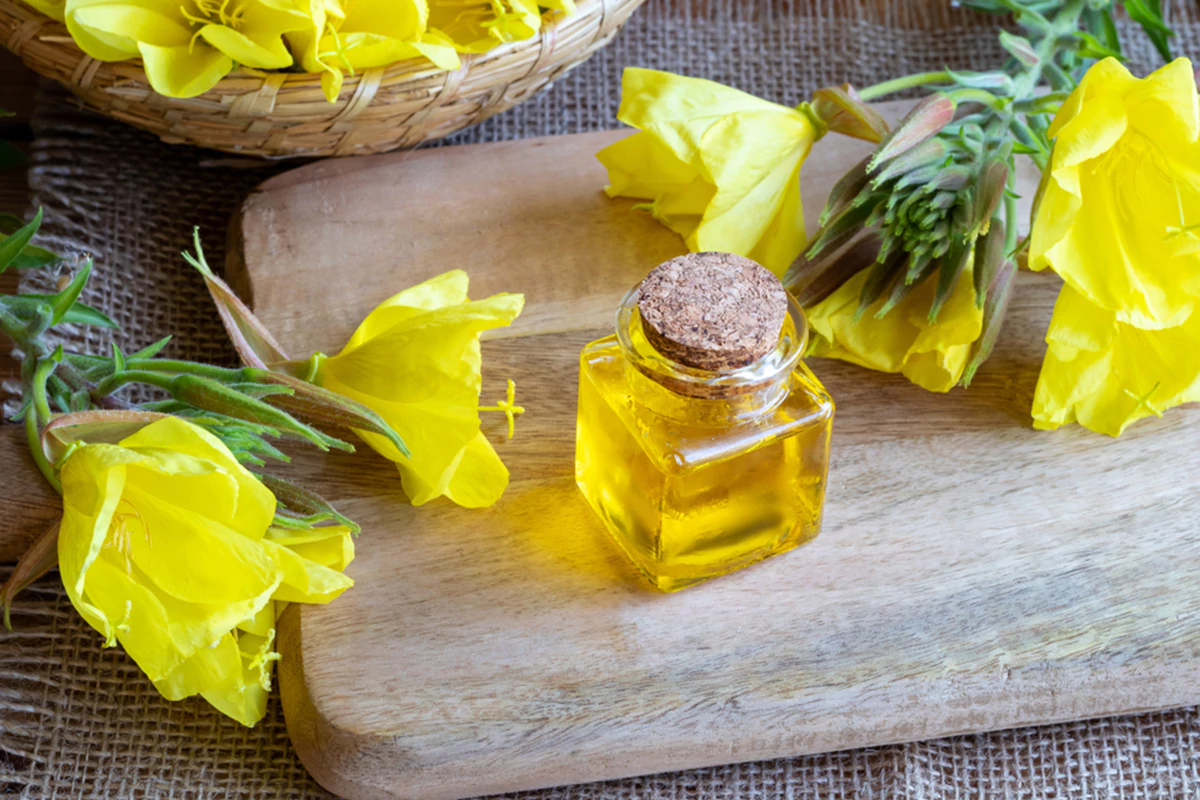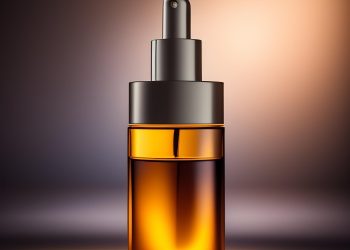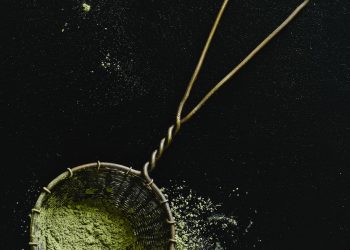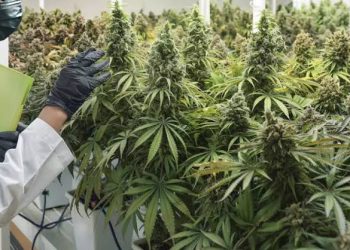Acne is a chronic disorder that is related to an increase in the secretion of sebum [1].
According to the American Academy of Dermatology, acne is the most common condition in the U.S. and affects up to 50 million Americans every year.
Because acne is so prevalent, a wide array of treatment is available from medicinal drugs to natural cures.
Evening primrose oil is one of the natural alternatives you can explore for treating acne.
There is strong medical research evidence to support the efficacy of evening primrose oil for acne treatment.
In this article, you will learn the properties, benefits, and uses of evening primrose oil for treating acne. Plus you’ll get a better understanding of the causes and different types of acne.
What is Evening Primrose Oil?
Evening primrose oil or EPO is extracted from the seeds of evening primrose, a plant that is native to North America [12].
This plant has yellow flowers that bloom in the evening, hence the name.
Native Americans used evening primrose to cure different types of ailments [12].
They used the whole plant to treat bruises, the roots for hemorrhoids, and the leaves for gastrointestinal distress, sore throats, and minor wounds [12].
These days, evening primrose oil is used as a dietary supplement, as a treatment for various diseases, and as a way to improve one’s appearance [12, 13].
RELATED: Aloe Vera Gel for Acne: 12 Sure-Fire Ways to Cure Acne
Why Use Evening Primrose Oil for Acne?
A number of research has been done to determine the effects of evening primrose oil or EPO on skin problems.
These are the results of some of the studies:
1. Omega-3 Fatty Acids, GLA Supplement and Acne vulgaris
Omega-3 fatty acids have been shown to limit the production of leukotriene B4, leukotriene that triggers inflammatory acne.
Gamma-linolenic acid, which is found in evening primrose oil, has anti-inflammatory properties when used topically and orally.
A study entitled “Effect of dietary supplementation with omega-3 fatty acid and gamma-linolenic acid on acne vulgaris: a randomized, double-blind, controlled trial” has demonstrated that Omega-3 fatty acids and GLA can be used as auxiliary treatments for acne patients [22]
2. Systemic EPO and Biophysical Skin Parameters
Biophysical skin parameters indicate the changes in the skin tissues in terms of structure and function.
These parameters include skin moisture, transepidermal water loss, skin elasticity, fatigue resistance, firmness, roughness, and redness.
A 2005 study published in the International Journal of Cosmetic Science has shown that EPO improves the biophysical skin parameters of healthy adults [23].
3. EPO and Atopic Dermatitis
Atopic dermatitis or AD is a chronic, itchy, and relapsing skin disease that is caused by several elements.
An important factor in the development of AD is the defective metabolism of essential fatty acids, causing an overabundance of PGE2 and PGF2, which are pro-inflammatory prostaglandins.
The results of a 2008 study showed that 96 percent of AD patients who were given EPO showed improvement, which led researchers to conclude that EPO “is a safe and effective medicine in the management of AD” [24].
4. EPO and Xerotic Cheilitis in Acne Patients Taking Oral Isotretinoin
A common treatment for acne, isotretinoin can cause adverse side effects like cheilitis, dryness of the skin, conjunctivitis, and dryness of the eyes.
Because EPO is known to improve transepidermal water loss and skin moisture in healthy adults, Korean researchers studied the effects of EPO on acne patients being treated with oral isotretinoin [25].
The researchers concluded that EPO improved xerotic cheilitis in acne patients taking isotretinoin orally [25].
5. EPO and melanogenesis in B16 melanoma cells as well as UV-induced skin pigmentation
A 2010 study sought to determine whether saponified EPO reduces melanogenesis in B16 melanoma cells and decreases UV-induced skin pigmentation [26].
The results suggested that sap-EPO can potentially be used as an agent for cosmetic whitening [26].
How You Can Use Evening Primrose Oil for Acne Treatment
Evening primrose oil has numerous benefits and uses for skin. Here are some simple ways to use EPO for treating acne:
1. Evening Primrose Night Oil
Evening primrose oil capsules for acne can calm down the flare-ups and treat inflammations. It is great to be used as a night moisturizer.
How many evenings primrose oil to take for acne:
- 1 capsule of EPO
Recommended Directions:
- Apply the oil lightly on your face or areas where you have acne.
- Apply any remaining oil on your arms or other body parts.
- Allow the oil to dry naturally.
- Wash with mild soap or cleanser the following day.
RELATED: Lemon Juice for Acne: 8 Simple Home Remedies
2. Evening Primrose, Jojoba, and Lemongrass Moisturizer
Jojoba is great for almost all skin types, including acne-prone skin. Lemongrass brightens and tones the skin, making it ideal to use when your skin needs a little “pick-me-up.”
What You’ll Need:
- 6 ml of evening primrose oil
- 4 ml of jojoba oil
- 5 drops of lemongrass essential oil
Recommended Directions:
- Place EPO and jojoba oil into a small bottle and mix well.
- Add one drop of lemongrass essential oil at a time.
- Mix well after adding each drop of lemongrass essential oil.
- Use this oil mixture as a moisturizer after your regular facial cleansing routine.
3. Evening Primrose and Argan Oil Day and Night Moisturizer
Argan oil is rich in vitamin E and fatty acid content. It is also easily absorbed by the skin so it can be mixed with EPO if you find EPO alone to be too greasy or heavy on the skin.
What You’ll Need:
- 5 ml of evening primrose oil
- 5 ml of argan oil
Recommended Directions:
- Place the oils into a small bottle and mix well.
- Use a few drops to moisturize your skin after your regular facial cleansing routine in the morning and at night.
RELATED: How to Use Argan Oil to Treat Acne + Other Benefits
4. Sea Buckthorn, Tea Tree, and Evening Primrose Oil for Skin Rejuvenation
Sea buckthorn oil has long been used in Russia to treat a variety of skin ailments. It has also been known to reduce the ill effects of cancer treatment.
What You’ll Need:
- 7 ml of evening primrose oil
- 3 ml. of sea buckthorn oil
- 5 drops of tea tree oil
Recommended Directions:
- Place the evening primrose oil and sea buckthorn into a small bottle and mix well.
- Add one drop of tea tree oil at a time.
- Mix well after each drop of tea tree oil is added.
- Use a few drops and massage lightly onto your face after your regular facial cleansing routine.
RELATED: How Apple Cider Vinegar Can Help You Get Rid of Your Acne
5. Evening Primrose and Lavender Serum
Apart from having a pleasant smell, lavender has antibacterial properties that penetrate the pores and kill bacteria.
What You’ll Need:
- 20 oz of evening primrose oil
- 20 drops of lavender essential oil
Recommended Directions:
- Place the oils into a bottle and mix well.
- Use after your regular facial cleansing routine.
- Place a drop of the serum on your forehead, on each of your cheeks, and chin.
- Massage lightly until the oil is absorbed into the skin.
RELATED: 6 Ways to Use Coconut Oil for Acne Treatment
6. Evening Primrose Oil as Acne Spot Treatment
Small pesky acne spots or pustules are a great deal of damage when it comes to your external appearance.
A direct topical application of evening primrose oil on the blemishes can quickly vanish the unsightly spots and rejuvenate your skin.
The skin exfoliating glycolic acids in primrose oil can flush out dirt and toxins and heal acne inflammations or hormonal acne.
What You’ll Need:
- 3-4 drops of evening primrose oil
- Cotton swab
Recommended Directions:
- Soak a cotton swab with evening primrose oil.
- Apply the oil to the acne spot.
- Leave it for 15-20 minutes.
- Wash off using cool water and pat dry with a fresh towel.
- Repeat the treatment thrice daily to get rid of hormonal acne.
Note: dilute evening primrose oil with olive oil, in case you experience skin irritation due to the undiluted form.
Other Benefits and Uses of Evening Primrose Oil
1. To Prevent Hair Loss
Hair loss is a problem that both men and women struggle with.
One of the best ways to prevent the loss of hair is by taking evening primrose oil, which contains gamma-linolenic acid (GLA), an essential omega-6 fatty acid.
The body converts GLA into prostaglandins, a hormone-like substance that plays different roles in the body’s biological processes [14, 15].
Apart from taking the supplement, you can also rub evening primrose oil on your scalp and hair, or add it to your shampoo to encourage hair regrowth.
2. To Reduce Breast Pain
Mastalgia or breast tenderness and pain usually accompanies monthly periods (also called cyclical mastalgia).
However, it is also possible for mastalgia to manifest without following any pattern (or noncyclical mastalgia).
A 2011 study published in Alternative Medicine Review has shown that a daily intake of 3,000 mg of evening primrose along with 1,200 IU of vitamin E improved the pain control and decreased the severity of the symptoms in women with cyclical mastalgia [16].
3. To Relieve the Symptoms of PMS
Mood swings, fatigue, irritability, depression, food cravings, and tender breasts are some of the symptoms women experience before their monthly period.
These symptoms are often referred to as premenstrual syndrome or PMS, which affects as many as 3 out of 4 menstruating women.
A study of the role of prostaglandins and essential fatty acids on PMS “demonstrated that evening primrose oil is a highly effective treatment for depression and irritability, breast pain and tenderness, and the fluid retention associated with the premenstrual syndrome” [17].
4. To Treat Rheumatoid Arthritis
A chronic inflammatory disorder, rheumatoid arthritis affects the lining of the joints, which leads to painful swelling that could eventually cause a joint deformity as well as bone erosion.
Rheumatoid arthritis, which is also an autoimmune disorder, can damage the eyes, lungs, heart, blood vessels, and skin.
In a 1989 report entitled “Evening primrose oil in rheumatoid arthritis: changes in serum lipids and fatty acids,” researchers found that evening primrose oil exhibited encouraging results in the treatment of rheumatoid arthritis patients [18].
5. To Offer Protection Against Heart Diseases
Consuming evening primrose oil has been shown to reduce high blood pressure and levels of bad cholesterol.
A 2011 study published in the Journal of Cardiovascular Pharmacology suggests that a combination of celecoxib and selected natural supplements, which include evening primrose oil, can minimize cardiovascular risk caused by celecoxib [19].
6. To Provide Potential Treatment to MS Patients
Multiple sclerosis is a disease of the brain and spinal cord.
In MS, the body’s immune system attacks myelin or the fatty substance that protects the nerve fibers, and the never fibers themselves.
As a result of the damaged myelin, nerve impulses traveling to and from the brain become disrupted, which produces different symptoms.
The preliminary results of a 1979 study entitled “Multiple sclerosis: the rational basis for treatment with colchicine and evening primrose oil” indicate that a combination of evening primrose oil and colchicine may be valuable in the treatment of Multiple sclerosis [20].
As with drugs and other supplements, taking EPO can have side effects.
Some of these side effects are:
- headache
- stomach upset
- nausea
- dizziness
- rash [21]
People with bleeding disorders, seizure disorders, and mania should be especially careful about taking EPO [21].
Drug interactions have also been reported so be sure to consult your doctor first before taking EPO along with your other medications.
Acne: Types and Major Causes
Main types of spots caused by acne:
- Blackheads – also called open comedones, blackheads are small yellowish or black bumps on the skin
- Whiteheads – also called closed comedones, whiteheads are similar to blackheads in appearance but are often firmer
- Papules – small bumps that may or may not feel tender or sore
- Pustules – appear similar to papules in appearance but have a white pus-filled tips
- Nodules – large hard lumps that develop under the surface of the skin and are often painful
- Cysts – large, pus-filled lumps that have the potential to cause permanent scarring
Acne is categorized into mild, moderate, and severe [1].
Mild acne refers to comedones or blackheads and whiteheads [1].
Acne is also considered mild if there are only a few pimples, which can be papules or pustules [1].
Moderate acne involves noticeably more pimples, most of which are inflamed [1].
Severe acne refers to a high number of papules, pustules, nodules, and cysts. [1].
The exact cause of acne is uncertain, but it could be anyone or a combination of the following:
1. Hormones
Acne in teenagers is believed to be caused by increased levels of the hormone testosterone. In boys, testosterone is essential in the growth and development of the penis and testicles.
In girls, testosterone is necessary for maintaining muscle and bone strength.
Because the sebaceous glands are especially sensitive to hormones, it is thought that the increased levels of testosterone during puberty cause the body to produce more sebum than the skin needs [2].
While boys are more prone to have acne than girls during adolescence, women are more prone to adult acne.
It is thought that changes in hormonal levels during periods, pregnancy, as well as certain conditions, such as polycystic ovary syndrome, cause adult acne in women.
2. Genes
Like other health conditions, acne can be inherited.
In fact, a 2006 study concluded that heredity is an important factor for acne and that “family history is associated with an earlier occurrence of acne, increased number of retentional lesions and therapeutic difficulties” [3].
3. Certain Medications
It is possible for certain types of medicine to cause acne flare-ups.
Lithium, which is used in treating depression and bipolar disorder, has been known to cause dermatological problems that include folliculitis, psoriasis, and acneiform eruptions [4, 5].
Topical corticosteroids while useful in treating various dermatological disorders can produce side effects that seriously damage the skin [6].
Some of these side effects include acne, rosacea or rosacea-like condition, and perioral dermatitis [6].
4. Smoking
Although research has had conflicting results about the effects of smoking on the development of acne, smoking has been found to be strongly connected to various dermatologic conditions including psoriasis, wrinkling, premature skin aging, and hidradenitis suppurative [7].
5. Stress
A worsening of acne during periods of stress is more than just a psychological effect.
Several studies have actually established the link between stress and acne flare-ups [8, 9, 10].
Acne Traditional Treatment Options
Today, there are various treatment options for people who are suffering from acne. In general, acne medications reduce oil production, speed up the turnover of skin cells (skin renewal), reduce inflammation, and fight the bacterial infection.
The potency of the drug your dermatologist will recommend depends on your skin type as well as the severity of your acne.
Acne medications come in topical and oral forms and are often used in combination.
Topical medications include:
- retinoids
- antibiotics (often combined with benzoyl peroxide to reduce the possibility of antibiotic resistance)
- dapsone [11]
Oral medications include:
- antibiotics
- combined oral contraceptives (in women and adolescent girls)
- anti-androgen agent
- isotretinoin (prescribed for people with severe acne) [11]
The following therapies may also be advised, alone or combined with medications:
- light therapy
- chemical peel
- blackhead and whitehead extraction
- steroid injection [11]
Furthermore, natural alternatives to treating skin problems are available, such as evening primrose oil. The oil can be used topically as well as orally.
Bottom Line
Whether you’re in your teens or in your 30s, you’ve probably experienced what it’s like to suffer from acne.
Evening primrose oil has been shown to offer plenty of health benefits.
You can use evening primrose oil for acne treatment at home as discussed above.
It is a great natural treatment alternative for those who want to have beautiful skin without the use of harsh chemicals.
READ MORE: Green Tea for Acne: How Effective?





